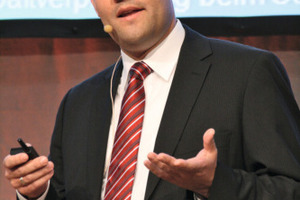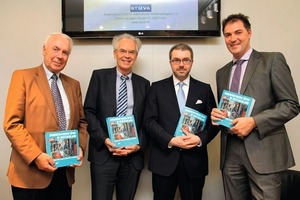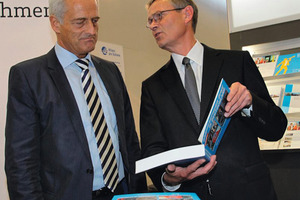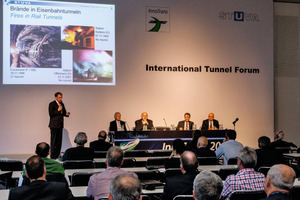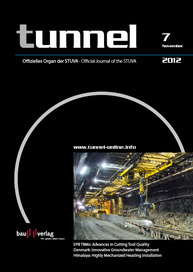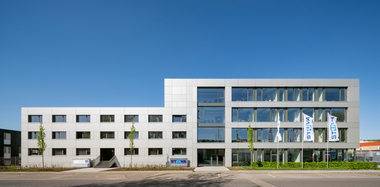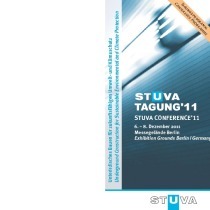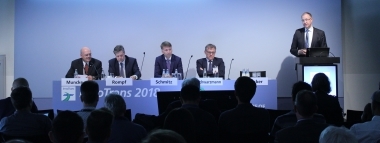STUVA news
Carl-Rappert-Grundbaupreis awarded to STUVA Staffer Dr.-Ing. Christian Thienert
Dr.-Ing. Christian Thienert, STUVA, was awarded the highest distinction of the German Geotechnical Society (DGGT) at the 32nd Baugrundtagung congress in Mainz, the first prize presented by the Keller Grundbau: the Carl-Rappert-Grundbaupreis. The purpose behind the Carl-Rappert-Grundbaupreis is to encourage young scientists to excel in the field of geotechnics. The award was made to honour Thienert’s research project “Cement-free Mortars for Grouting the annular Gap during Shield Driving with fluid-supported Face” and its particular significance for geotechnics.
In his paper, Dr. Thienert (Fig. 1) indicates how cement-free annular gap mortars are at least as effective as conventional mortars containing cement in ground possessing sufficient permeability. Indeed they frequently develop a higher early bedding strength, which is a decisive advantage in avoiding damage to segments. In addition, he came up with fundamentally new findings relating to the transference of supporting pressure, which are of great practical relevance for contemplating stability both during tunnel drives with fluid-support as well as for diaphragm walls.
The second and third prizes in the Carl-Rappert-Grundbaupreis series went to Mrs. Dipl.-Ing. Bozhana Stefanova of the TU Hamburg-Harburg and Dr.-Ing. Emanuel Birle of the TU Munich. An independent jury comprising Prof. Rolf Katzenbach, Prof. Peter-Andreas von Wolffersdorff and Dr.-Ing. Wolfgang Sondermann decided on the recipients of the awards.
STUVA Research Results published as Book “Barrier-free Public Transport in Germany” – 2nd completely revised and expanded edition in the VDV’s “Blue Series”
Currently (2012) there are around 9.6 million people in Germany with some form of disability. Many other persons have their mobility affected either on a permanent or temporary basis when it comes to using public transport, although this is not necessarily reflected in the extent to which they are handicapped. This group, which currently accounts for more than 30 % of the population in Germany, includes the elderly, children as well as passengers with prams or luggage. Based on demographical developments this group will grow substantially in the years ahead on account of the greater number of older people.
The STUVA tackled the resultant high demands posed on barrier-free public transport in a now concluded research project “Analysis of the current Level of Development of barrier-free Solutions for Persons restricted in their Mobility in Public Transport.” The project was funded by the Federal Ministry for Transport, Building and Urban Affairs as well as the VDV Förderkreis and published in the Association of German Transport Companies (VDV) “Blue Series”. The book contains more than 600 pages and was recently presented at the InnoTrans 2012 by VDV president Jürgen Fenske to federal transport minister Dr. Peter Ramsauer (Fig. 3) with the STUVA introducing it to a large circle of experts (Fig. 2).
The book was implemented as a completely revised new edition of “Barrier-free Public Transport in Germany”. It examines the latest measures for tackling the issue of accessibility in all sectors of public transport – from vehicles by way of infrastructure right up to information and service. Furthermore it presents current legal principles at national and European level and the latest technical codes of practice. In addition, the many amendments brought about by current legislation are explained, practical findings obtained in recent years summarised and recommendations for the future derived from them. Based on numerous examples from practice and research diverse recommendations and solutions to implement barrier-free public transport for new urban development projects as well as redeveloping existing facilities and vehicles are provided to ensure that public transport is capable of providing mobility for everyone.
More than 10 years ago the first edition of the publication tried to sum up efforts designed to arrive at an overall concept for barrier-free public transport. Here for the first time, extensive possible solutions for a continuous development process based on numerous practical examples were provided taking both operational requirements and economic limits into account. The completely revised new edition now available represents an up-to-date version after many years designed to replace the now out-of-print but still in demand original. The book – published in German and English – is intended to emphasis the international significance of the topic and propel the comprehensive recognitions that have been gained in the interim far beyond national boundaries. The book is obtainable via the book trade or directly from the Alba Fachverlag for 97.— euros.
Underground Construction at the InnoTrans 2012 in Berlin
“Tunnels represent an important part of the infrastructure” was the message passed on by STUVA CEO, Dr. Roland Leucker, during the press conference marking the start of the InnoTrans, the world’s biggest transport technology fair. He provided the journalists in attendance with an insight of the advantages, which result from installing the necessary infrastructure beneath the surface, with relevant exam-ples pertaining to increasing the need for mobility and cutting travelling times.
Further aspects of Underground Construction were dealt with at the international tunnel forums held within the scope of the InnoTrans Convention (Fig. 4).
At the first forum, Prof. Wolfgang Baltzer, the chairman of the board of BUNG Ingenieure AG and the RABT Committee, Bruno Bouthors, director of Safety and Sustainable Development, Eurotunnel, Dr.-Ing. Jens Böhlke, president of the Department of Infrastructure at the Federal Railway Authority and Dipl.-Ing. Otto Schließler, head of Dortmund’s Light Railway Construction Office discussed the issue “User Safety - a Balancing Act between Vehicle and Tunnel Design?” The discussion honed in on the optimal approach to the special challenges posed by combating fire in underground facilities. Needless to say the opportunities for evacuating users as well as the deployment of rescue services played a role.
It was unanimously agreed that combating fire as soon as possible within the railway vehicle itself can greatly reduce its effects. Notwithstanding preventive measures in the stations and stops are also required.
“It doesn’t function without the inclusion and involvement of affected residents”. The podium participants at a further tunnel forum staged at the InnoTrans Convention agreed on this. With regard to “Infrastructures for Europe – major Targets without major Projects?”, Dipl.-Ing. Wolfgang Arnold, technical director of the Stuttgarter Straßenbahnen AG and head of the VDV working group for compiling guidelines to accomplish major projects, Steen Lykke, technical director of Fehmarn A/S and project manager of the Fehmarn Belt Crossing, Luc Vanasteenkiste, the director-general for infrastructure of Infrabel, the Belgian rail infrastructure authority and president of RailNetEurope and Dr. Georg-Michael Vavrovsky, board member of the ÖBB-Infrastruktur AG dealt with tackling major projects. Nowadays it is essential to provide those directly affected by a major infrastructure project with a precise insight of the effects and the need for such a scheme prior to its inception. After all engineers regard themselves as acting in the interests of the general public by fulfilling their desire for mobility.
The forums were staged for the fourth time by STUVA in conjunction with the Messe Berlin. In terms of content they dovetail with the Tunnel Construction segment at the fair. This year the forums appealed to a particularly large number of trade visitors. A factor, which underlined yet again, the growing significance of underground facilities for a modern and sustainable infrastructure.

